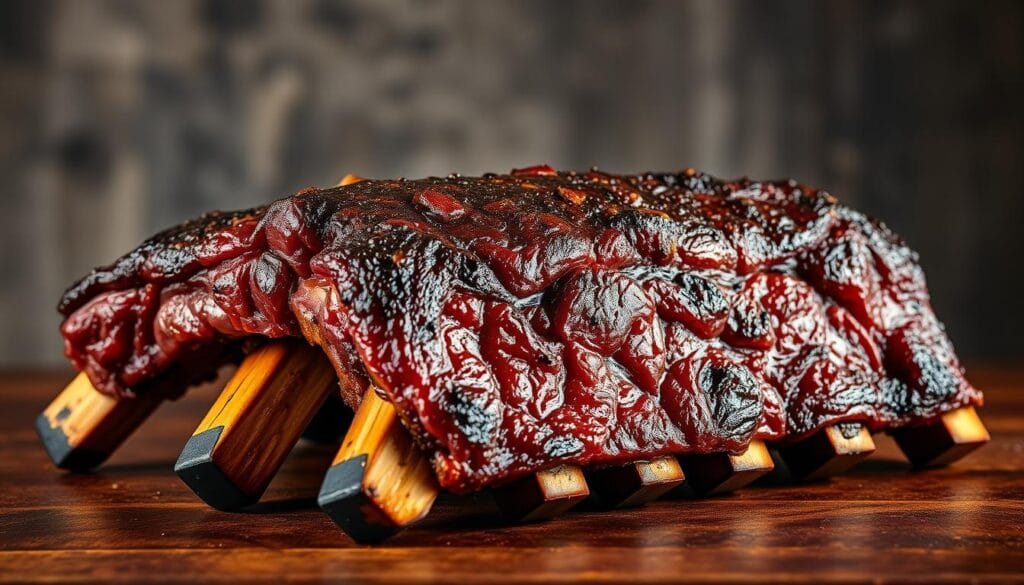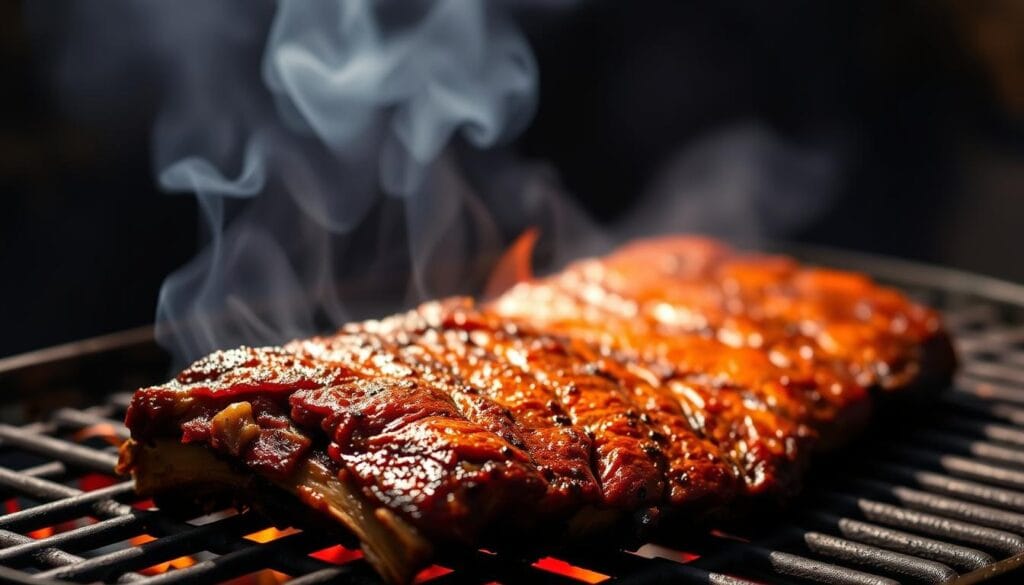Craving tender and juicy beef ribs but don’t have all day to wait? You’re not alone. Many of us love the rich flavor of slow-cooked meat, but sometimes, time is of the essence.
Imagine sinking your teeth into fall-off-the-bone tender beef ribs recipe that have been cooked to perfection in under 2 hours. Sounds too good to be true? With the right techniques and a bit of know-how, you can achieve this culinary dream without spending the entire day in the kitchen.
This recipe is designed to give you the authentic flavor of slow-cooked beef ribs in a fraction of the time. By utilizing specific temperature techniques and preparation methods, you can enjoy restaurant-quality results at home.
Key Takeaways
- Learn how to make tender and juicy beef ribs in under 2 hours.
- Understand the science behind achieving perfectly cooked ribs quickly.
- Discover how to balance convenience with authentic flavor.
- Find out how this method works for various cuts of beef ribs.
- Achieve restaurant-quality results at home without extended cooking.
The Secret to Perfect Beef Ribs
Achieving perfect beef ribs is a culinary goal for many, and it starts with understanding the key elements that make them exceptional. The recipe we’re diving into creates a truly unforgettable dining experience with its combination of tender meat, rich BBQ sauce, and a perfectly balanced rub.
Why This Recipe Works
This beef ribs recipe stands out due to its meticulous balance of flavors and textures. The key to its success lies in several factors:
- The development of a distinctive bark-like exterior that contrasts with the moist interior.
- A blend of sweet, savory, and tangy flavors that penetrate deep into the meat.
- A cooking method that ensures the ribs are tender without falling apart.
These elements combine to create a dish that’s both satisfying and full of flavor.
What Makes These Ribs Special
These beef ribs are special because they achieve that perfect balance between tenderness and texture. The cooking process creates a natural, silky BBQ sauce from the beef’s own juices, which combines with the seasonings for an intensely flavored finish. Unlike many quick-cook methods, this recipe doesn’t sacrifice flavor for speed, maintaining the deep, rich beef flavor that makes ribs so desirable.
The result is a dish that’s not just delicious but also visually appealing, making it perfect for any gathering.
Choosing the Right Beef Ribs
Selecting the perfect beef ribs is crucial for achieving tender, fall-off-the-bone results. The type and quality of beef ribs you choose will significantly impact the final outcome of your dish.
Types of Beef Ribs
Beef ribs come in various types, but the most common are beef short ribs and back ribs. Beef short ribs are meaty and flavorful, making them ideal for slow cooking or braising. They are typically cut into portions that include a portion of the rib bone and a generous amount of meat.
Back ribs, on the other hand, are leaner and may require a different cooking approach to achieve tenderness. Understanding the differences between these types will help you make an informed decision based on your cooking method and preferences.
| Type of Ribs | Description | Best Cooking Method |
|---|---|---|
| Beef Short Ribs | Meaty, flavorful, includes rib bone | Braising or slow cooking |
| Back Ribs | Leaner, less meat | Grilling or oven roasting with wrapping |
What to Look for When Buying
When purchasing beef ribs, there are several factors to consider to ensure you get the best quality. Look for ribs with generous meat coverage; at least 1-inch thickness on top of the bones is ideal for quick-cooking methods. Good marbling throughout the meat is also crucial as it contributes to moisture and flavor.
Avoid pre-seasoned or brined ribs, often sold in vacuum-sealed packages, as they can throw off the salt balance in your recipe. Fresh ribs should have a bright red color with white fat. Avoid packages with excessive liquid or ribs with grayish coloring.

It’s also beneficial to purchase from a butcher who can cut the ribs to your specifications, ensuring uniform size for even cooking. Remember, beef ribs shrink about 30% during cooking, so opting for bigger, meatier ribs is advisable, though smaller ones (~250g/8oz) can still yield good results.
Essential Beef Ribs Recipe Ingredients

The secret to perfect beef ribs is in the ingredients and preparation. To achieve tender and flavorful beef ribs, you’ll need to focus on two main components: the dry rub and the BBQ sauce. Both elements are crucial in creating a delicious beef ribs recipe.
For the Dry Rub
The dry rub is a blend of spices that adds depth and complexity to the beef ribs. The key ingredients include garlic powder, paprika, and chili powder, which provide a savory flavor. You can also add other spices like cumin, coriander, or cayenne pepper to suit your taste preferences.
The dry rub should be applied evenly to the beef ribs, ensuring that they are fully coated. This helps to create a flavorful crust on the ribs during cooking.
For the BBQ Sauce
The BBQ sauce is a vital component of the beef ribs recipe, providing a sweet, tangy, and savory flavor. The homemade BBQ sauce uses ketchup as its base, providing tomato richness, sweetness, and thickness that clings well to the beef ribs during cooking.
- Apple cider vinegar adds essential acidity that balances the sweet elements and helps tenderize the meat more quickly than traditional slow methods.
- Brown sugar contributes to the caramelization process, creating that sticky, glossy finish that makes these quick-cooked ribs look and taste like they’ve been smoking all day.
- Worcestershire sauce adds umami depth and complexity, enhancing the beefy flavor with its fermented richness.
- The addition of mustard (either powder or prepared) provides a tangy undertone that cuts through the richness of the beef ribs and adds dimension to the sauce.
By combining these ingredients, you’ll create a BBQ sauce that’s both flavorful and tangy, perfect for glazing your beef ribs during the last stages of cooking.
Step-by-Step Cooking Instructions
To achieve tender and flavorful beef ribs, follow these step-by-step cooking instructions carefully. The process involves preparing the ribs, applying a dry rub, cooking them in the oven, and checking for doneness.
Preparing the Ribs
Start by removing the membrane from the back of the beef ribs. This step is crucial as it allows the rub to penetrate the meat more effectively. You can use a paper towel to grip the membrane and peel it off. Once removed, your ribs are ready for the next step.
Place the ribs on a large sheet of aluminum foil, bone side down. This positioning helps the meat cook evenly and prevents it from drying out.

Applying the Rub
Generously apply the dry rub to the beef ribs, making sure to coat all surfaces evenly. The rub should adhere well to the meat, enhancing the flavor. You can use your hands or a spatula to ensure an even coating.
After applying the rub, let the ribs sit at room temperature for about 30 minutes. This allows the seasonings to penetrate the meat.
Oven Cooking Method
Preheat your oven to 250 degrees Fahrenheit. Place the ribs, still on the foil, on a baking sheet and cover with another sheet of foil. This setup helps to trap moisture and heat, ensuring tender ribs.
Cook the beef ribs in the preheated oven for about 2 hours. The low and slow cooking method breaks down the connective tissues, making the meat tender and easily separable from the bone.
| Cooking Time | Oven Temperature | Result |
|---|---|---|
| 2 hours | 250°F | Tender and flavorful beef ribs |
| 4 hours | 225°F | Fall-off-the-bone tender ribs |
How to Know When They’re Done
To check if your beef ribs are done, perform a few simple tests. First, look for visual cues such as meat pulling back from the bones and a deep, caramelized color on the surface.
You can also use the bend test: pick up the rack with tongs and gently bend it. Properly cooked ribs will bend significantly and may crack on the surface. Another method is to insert a toothpick or probe between the bones; if it slides in with minimal resistance, the ribs are done.
When the ribs are done to your liking, remove them from the oven and drain off the excess fat. Let them rest for a few minutes before serving.
Serving Your Juicy Beef Ribs
After cooking your beef ribs to perfection, the final touch is to present them with style and flair. Allow the ribs to rest for 5-10 minutes after removing from the oven, which helps the juices redistribute throughout the meat for maximum juiciness.
Serve the ribs with additional warmed BBQ sauce on the side for dipping or drizzling. Complement the rich, savory beef with bright, acidic side dishes like vinegar-based coleslaw or a tangy cucumber salad.
Consider pairing your beef ribs with a bold red wine or a craft beer. For a more elegant presentation, slice the meat off the bone and arrange it on a platter with the bones artfully displayed, drizzled with additional sauce and garnished with fresh herbs.
FAQ
What type of beef ribs should I use for this recipe?
How do I store leftover ribs?
Can I make this recipe in a smoker instead of the oven?
What’s the best way to apply the dry rub to the ribs?
How do I know when the ribs are done cooking?
Can I use a different type of BBQ sauce for this recipe?
Check more about BBQ Beef Ribs That Impress Here
